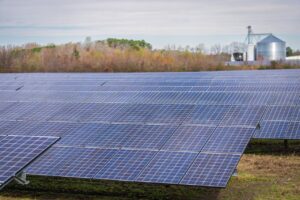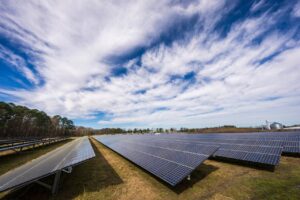Establishing a Leadership Position in the Southeast
In 2007, North Carolina became the first southern state to create a clean energy standard for investor-owned utilities in the state. The Renewable Energy and Energy Efficiency Portfolio Standard (REPS), now known as the Clean Energy and Energy Efficiency Portfolio Standard (CEPS), remains the only standard of its kind in the southeast and set North Carolina on a path to being a clean energy leader in the region. However, in recent years, deployment of clean energy projects in North Carolina has significantly slowed, decreasing the state’s standing and slowing its progress towards winning the future in a clean energy economy.
CEPS required investor-owned utilities to supply 12.5% of 2020 retail electricity sales from eligible energy resources by 2021. Municipal utilities and electric cooperatives had to meet a target of 10% renewables by 2018. Additionally, in 2019 the state established a Clean Energy Plan (CEP) with three specific goals:
- Reduce electric power sector’s greenhouse gas emissions by 70% below 2005 levels by 2030 and attain carbon neutrality by 2050;
- Foster long-term energy affordability and price stability for North Carolina’s residents and businesses by modernizing regulatory and planning processes;
- Accelerate clean energy innovation, development, and deployment to create economic opportunities for both rural and urban areas of the state.
To meet its goals, the CEP has three overarching recommendations, including accelerating retirement of coal as an energy source, developing and implementing policies and tools to better align utility incentives with public interest and grid needs, and modernizing the grid to support the adoption of clean energy while fostering more resilience.
The impact of both the CEPS and the CEP has been profound. In 2022, North Carolina was ranked the #1 state in SmartAsset’s “States Leading the Charge on Renewable Energy” report, and in 2023, was chosen as the top state for sustainability by Site Selection magazine. In addition, net emissions of greenhouse gasses in North Carolina fell by 38% between 2005 and 2020.
Has this focus on clean energy hurt North Carolina’s ability to compete for manufacturing jobs? Quite the contrary. It has attracted a large number of clean energy companies, along with a significant infusion of federal investment funds, bolstered by the largest workforce in the region with over 474,000 workers skilled in machinery, maintenance, technology, and engineering.
Clean Energy Leadership at Risk
North Carolina’s early decision to embrace clean energy has clearly paid dividends. However, the state’s regional leadership on clean energy is being undermined by a recent North Carolina Utilities Commission order that changes how the state will achieve the ambitious goals laid out in the CEP. The new approach delays the retirement of coal-derived energy and allows the state’s largest power utility, Duke Energy, to build four new methane gas plants, effectively swapping one fossil fuel for another.
Clean energy advocates are alarmed at the new plan. For example, Jake Duncan, the Southeast Regulatory Director at Vote Solar, says the new order is a step in the wrong direction.
“The North Carolina Utilities Commission’s ruling allowing Duke to…miss the important milestone of 70% carbon reduction by 2030, is unacceptable,” Duncan said. “While the order does call for important new utility-scale solar, batteries and wind resources – by allowing Duke to delay coal retirement and build four new methane gas plants the NCUC missed a pivotal opportunity to move away from a fossil fuel centered energy system to a resilient and distributed clean energy future that prioritizes people over profits.”
Because Duke Energy has a regional energy monopoly, it wields extraordinary power. The future of North Carolina’s leadership on clean energy will largely depend on the actions taken by the company going forward.










